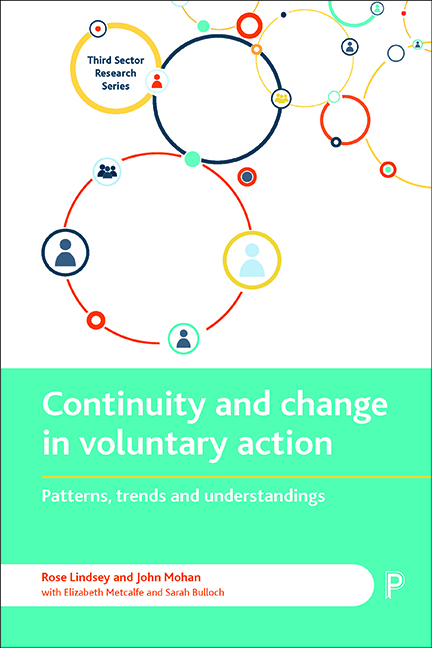Book contents
- Frontmatter
- Contents
- List of figures and tables
- Foreword
- Acknowledgements
- Notes on authors
- Acronyms
- one Introduction
- two The changing policy environment for voluntary action from 1979
- three Data: sources and definitions
- four Trends in volunteering and trends in the voluntary sector
- five Content and context of volunteering
- six Why people volunteer: contextualising motivation
- seven Volunteering trajectories: individual patterns of volunteering over the lifecourse
- eight Attitudes to voluntary action
- nine Conclusions
- Appendix: Anonymised details of writers
- References
- Index
three - Data: sources and definitions
Published online by Cambridge University Press: 13 April 2022
- Frontmatter
- Contents
- List of figures and tables
- Foreword
- Acknowledgements
- Notes on authors
- Acronyms
- one Introduction
- two The changing policy environment for voluntary action from 1979
- three Data: sources and definitions
- four Trends in volunteering and trends in the voluntary sector
- five Content and context of volunteering
- six Why people volunteer: contextualising motivation
- seven Volunteering trajectories: individual patterns of volunteering over the lifecourse
- eight Attitudes to voluntary action
- nine Conclusions
- Appendix: Anonymised details of writers
- References
- Index
Summary
Introduction
In this chapter we describe the secondary quantitative and qualitative data that we have used in this study. Our quantitative data are drawn from a range of robust and authoritative cross-sectional and longitudinal studies, and are complemented by rich longitudinal qualitative data from the Mass Observation Project (MOP). We consider the ways in which volunteering and community engagement are conceived of and measured, and the challenges posed for analysts by the particular nature of these two types of source. Each dataset has different definitions of voluntary action; we reflect on these definitions, and on how they may influence the responses given by participants. We describe the ways in which we sampled from each source, and consider the question of representativeness. A further section then considers the possibilities for, and challenges associated with, simultaneous usage of the MOP and social survey datasets.
Collectively the data sources constitute a considerable resource for exploring change in voluntary action in the UK over a long period of time. In practice, most of the quantitative datasets used relate to England, or to England and Wales (see discussion below), while nearly all the MOP writers sampled live in England, with a small number living elsewhere in the UK. Within the longitudinal datasets, tracking of individuals is possible for considerable periods of time – at least a decade, in the case of the British Household Panel Survey (BHPS), while the MOP material likewise permits us to follow individuals through extensive parts of their lives. The juxtaposition of the qualitative and quantitative material is also novel, with the qualitative data from MOP adding considerable depth to the survey data, while the latter provides context for the former. While no individual dataset has tracked individuals or measured volunteering in an identical manner throughout the period of our study, there is sufficient consistency within datasets, and in the overlaps between the periods for which individual surveys are available, to justify using the various sources to analyse continuity and change in voluntary action from the early years of the Thatcher government (the first survey dataset we use is for 1981) through to the Conservative government of Theresa May (although the last MOP directive we have used for this study was issued in 2012).
- Type
- Chapter
- Information
- Continuity and Change in Voluntary ActionPatterns, Trends and Understandings, pp. 39 - 60Publisher: Bristol University PressPrint publication year: 2018

